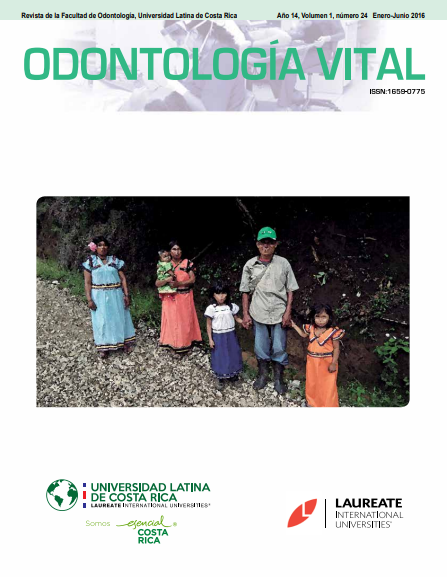Multidisciplinary smile design: clinical case
DOI:
https://doi.org/10.59334/ROV.v1i24.254Keywords:
DSD, Veneer, Aesthetic, Gingival RecontouringAbstract
The Digital Smile Design (DSD) is a tool used to plan and perform a dental treatment. It allows the patient to involve with the dental specialist during the planning, by sharing and expressing their desires and expectations.
This tool also helps the patient visualize the final results of their treatment. This article explains a clinical case where a smile of a 50 years old female patient was design in a multidisciplinary way.
To obtain an aesthetic result, it was necessary to perform a gingival recontouring of the upper anterior area, 3 months after the surgery the patient was ready to continue with the treatment, and finally cement 5 feldespathic porcelain veneers and 1 lithium disilicate crown.
Downloads
References
Allen, E. (1988). Procedimientos mucogingivales para mejorar la estética. Clínicas Odontológicas de Norteaméri-ca. Editorial Interamericana McGraw-Hill. 2.
Balda G, Herrera J, Frías M, & Carasol M., (2006). Erupción pasiva alterada: Implicaciones estéticas y alternativas terapéuticas. Disponible en: SciELO: http://scielo.isciii.es/scielo.php?pid=s1138-123x2006000500005&script=sci_arttext&tlng=es
Charruel S, Pérez C, Foti B, Camps J, & Monnet V. (2008). Gingival Contour Assessment: Clinical Parameters Use-ful for Esthetic Diagnosis and Treatment. J. Periodontol. 79 (5). https://doi.org/10.1902/jop.2008.070488
Chu S., (2007). Range and Mean Distribution Frequency of Individual Tooth Width of the Maxilary Dentition. Practical Procedures & Aesthetic Dentistry. 19 (4): 1-7.
Coachman C., Ricci, A., Calamita, M., (2012). Digital Smile Design: A Digital Tool for Esthetic Evaluation, Team Communication and Patient Management.
Coachman C, Van Dooren E, Gürel G, Landsberg C, Calamita M, & Bichacho N. (2010). Smile Design: From Digital Treatment Planning to Clinical Reality.
Otttoni J, Fardin L. (2007). Sonrisa Gingival. Cirugía Plástica Periodontal y Periimplantar: Belleza con Propor-ción y Armonía. Editorial Artes Médicas Ltds.
Paolucci B, Calamita M, Coachman C, Gürel G, Shayder A, & Hallawell P. (2007). Visagism: The Art of Dental Composition.
Terry, D., (2009). Principles of Tooth Preparation. Veneer Preparation Design. In D. Terry, Aesthetic & Restorative Dentistry: Material Selection & Technique. Everest Publishing Media. 66-71.
Terry, D. (2009). Provisionalization. Direct Fabrication of a Provisional Veneer. In D. Terry, Aesthetic & Restorative Dentistry: Material Selection & Technique. Everest Publishing Media. 344-347.
Terry, D. (2009). Elastomeric Impression Materials. In D. Terry, Aesthetic & Restorative Dentistry: Material Selec-tion & Technique. Everest Publishing Media. 250-275.
Terry, D. (2009). Contemporary Adhesive Cements. In D. Terry, Aesthetic & Restorative Dentistry: Material Selec-tion & Technique. Everest Publishing Media. 277-314.
Downloads
Published
Issue
Section
License
Copyright (c) 2016 Andrea Lizeth Cantú Moreira, Cynthia Colón Reynoso, Raúl Mario Benavides Garza, Alfredo Salinas Noyola

This work is licensed under a Creative Commons Attribution 4.0 International License.
Authors who publish with Odontología Vital agree to the following terms:
- Authors retain the copyright and grant Universidad Latina de Costa Rica the right of first publication, with the work simultaneously licensed under a Creative Commons Attribution 4.0 International license (CC BY 4.0) that allows others to share the work with an acknowledgement of the work's authorship and initial publication in this journal.
- Authors are able to enter into separate, additional contractual arrangements for the non-exclusive distribution of the Odontología Vital's published version of the work (e.g., post it to an institutional repository or publish it in a book), with an acknowledgement of its initial publication.
- Authors are permitted and encouraged to post their work online (e.g., in institutional repositories or on their website) prior to and during the submission process, as it can lead to productive exchanges, as well as earlier and greater citation of published work.







